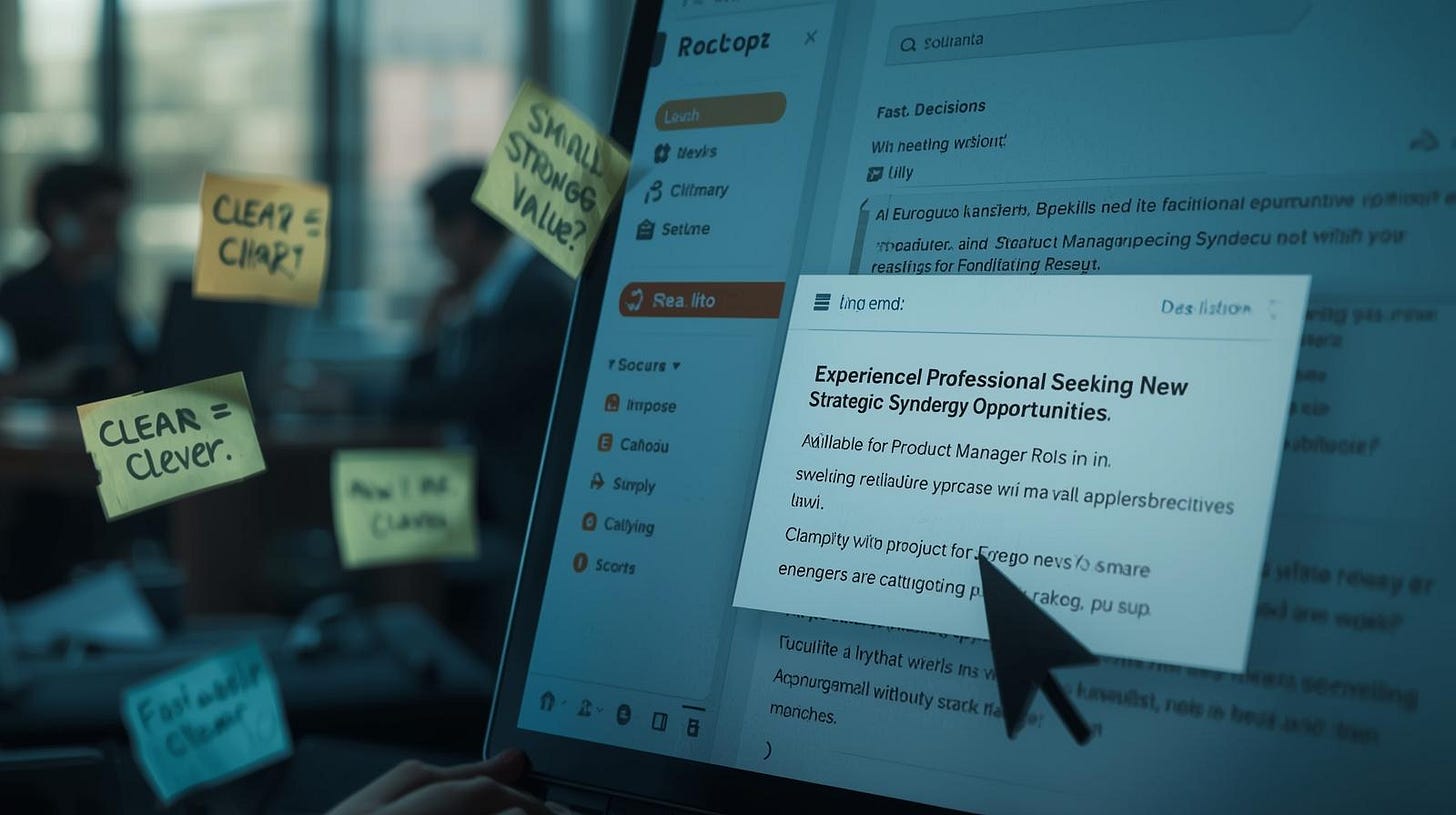Why Readability Can Make or Break Your Job Search
Recruiters skim, not read. Clear, readable LinkedIn profiles build trust, show confidence, and help you get noticed faster in global hiring searches.
Recruiters read fast. Most scroll through dozens of profiles in minutes on LinkedIn, scanning for keywords, job titles, and a few clear results that tell them whether someone might fit. In that quick scroll, clarity wins.
When your profile or post is easy to read, it feels trustworthy. That’s not just intuition, it’s psychology. Research in SAGE Journals calls it processing fluency - the idea that people judge information as more credible and likable when it’s easier to understand. In hiring, that means your choice of words, structure, and tone all shape how recruiters perceive you.
Global hiring makes this even more important. You might be writing in English to someone whose first language isn’t English. A recruiter in France could be reviewing candidates from Spain, or a hiring manager in India might be sourcing someone in Germany. Using simple, direct English helps your message land clearly, no matter who’s reading it.
Readable profiles (or résumés) are not about dumbing down. They’re about removing friction, making your value visible fast, and showing that you can communicate clearly across cultures.
Recruiters Read Fast, Not Deep
Recruiters rarely read word for word. They scan. In most cases, a recruiter spends dozens of seconds deciding if your profile is worth a closer look. That quick decision is based on what their eyes catch first: clear job titles, a short headline, visible skills, and measurable results.
Eye-tracking studies by the Nielsen Norman Group show that people online don’t read in a straight line. Instead, they move their eyes in an F-shaped pattern, scanning the first few lines, then jumping down the page, focusing only on bolded or highlighted parts. That means your most important information has to be easy to find and even easier to understand.
Readable writing helps you here. It guides the recruiter’s eyes and reduces cognitive load - the mental effort needed to process what they see. If your profile uses long blocks of text, complex sentences, or buzzwords, it slows them down. When that happens, they move on.
Here’s how to make your profile work for scanning eyes:
Use short paragraphs (3–4 sentences max).
Start each section with a clear summary of results or skills.
Replace filler phrases with facts: “Improved customer satisfaction by 25%” reads better than “Responsible for customer success initiatives.”
Add white space between sections so the page feels open and approachable.
A recruiter’s attention is a moving target, but readable writing stops the scroll. It shows that you respect their time, know how to communicate clearly, and can make complex work sound simple - qualities that matter in every role.
Processing Fluency and Why It Matters
Have you ever read something that felt effortless to understand? That’s processing fluency in action. It’s the psychological principle that when information is easier to process, we judge it as more truthful, credible, and likable.
Research published in SAGE Journals explains that people unconsciously use fluency as a shortcut for trust. When text is clear and flows smoothly, readers think, this person knows what they’re talking about. When it’s dense or full of jargon, they think the opposite - even if the content is accurate.
This bias matters in hiring. Recruiters don’t have time to decode complex writing. If your profile takes effort to read, they’re less likely to believe you’re organized, confident, or easy to work with. On the other hand, when your writing feels simple and natural, it signals that you can explain things clearly: a key skill in any job.
Here’s what that means for your job search:
Readable writing builds trust fast. Recruiters associate clarity with honesty and competence.
Complex text creates friction. The harder it is to read, the less likely someone is to keep reading.
Smooth writing feels credible. Studies show people rate easier-to-read information as more accurate and professional.
You can use this to your advantage. Shorter sentences, familiar words, and logical structure make your ideas “feel” smarter, not simpler. The goal isn’t to impress with vocabulary, but to connect through clarity.
In hiring, being understood quickly is often the difference between being noticed and being ignored. Processing fluency helps you land in that first group.
Global Hiring Means Global English
Today, most recruiting happens across borders. A recruiter in Paris might be sourcing candidates in Madrid. A hiring manager in Prague could be reading profiles from India. English is often the common language, but that doesn’t mean everyone reads or writes it the same way.
According to EF Education First’s English Proficiency Index, language comfort levels vary widely across countries and even between cities. That means your profile or LinkedIn message might be read by someone whose English is functional but not fluent. In that context, complex phrasing or idioms can confuse more than impress.
Here’s the thing: clear English travels better than clever English. When you keep your writing simple, more people understand your value. Using plain words and direct structure helps your message reach recruiters everywhere, no matter their native language.
A few practical adjustments make a big difference:
Avoid idioms. Phrases like “hit the ground running” or “wear many hats” don’t always translate well.
Spell out acronyms the first time you use them, especially technical or industry-specific ones.
Use international English. Choose words that mean the same thing everywhere. For example, write “bachelor’s degree” instead of “college degree,” or “manager” instead of “line lead.”
Be precise with dates. Always write the month name instead of numbers to avoid confusion (for example, “June 2024” instead of “06/07/24”).
Global hiring rewards clarity. A readable, plain-language profile signals that you can communicate across cultures - something companies value more every year. When your English works for everyone, your opportunities expand far beyond your home market.
Make Your English Work Across Cultures
Recruiters and hiring managers around the world use English to communicate, but not all use it the same way. What sounds natural in London might sound confusing in Tokyo or São Paulo. If your goal is to attract global opportunities, your writing needs to work for readers whose first language may not be English.
International companies value clarity and inclusiveness in communication. That means avoiding idioms, slang, humor, or phrasing that depends on local culture. A recruiter in another country might understand every word you wrote but still miss the meaning behind a phrase. Keeping your English simple, direct, and neutral helps everyone understand you the same way.
1. Avoid idioms and local expressions
Expressions like “hit the ground running,” “think outside the box,” or “back to the drawing board” might sound natural in conversation but don’t translate well. They can confuse non-native readers or sound informal. Replace them with clear alternatives:
“Start quickly” instead of “hit the ground running.”
“Find new ideas” instead of “think outside the box.”
“Review the plan again” instead of “back to the drawing board.”
2. Keep tone neutral and polite
Tone can get lost in translation. Humor, sarcasm, or local sayings may not carry the same meaning abroad. Keep your tone friendly but professional, using polite connectors such as please, thank you, and I appreciate your time. These are universally understood and respected.
3. Test your writing with international readers
If you work in a global team or know someone from another country, ask them to read your profile or post. They can quickly point out confusing phrases or terms that don’t make sense outside your culture. This “global read test” helps ensure your content connects with a wider audience.
Why this matters
Language clarity builds trust. A recruiter who can easily read and understand your message is more likely to contact you. A profile written in clear, globally friendly English sends a strong message—you’re someone who communicates well, adapts across cultures, and understands how international work really functions.
In global recruiting, communication is your first skill on display. The simpler and clearer your English, the more people will see you as someone who can collaborate confidently anywhere in the world.
Proof That Simple Writing Works Online
There’s a reason why the world’s biggest websites, governments, and research groups rely on plain language. It works.
The Nielsen Norman Group, which has studied how people read online for decades, found that users rarely read word for word. Instead, they skim headlines, glance at the first few sentences, and jump around looking for what matters most. When writing is simple and scannable, readers find answers faster, stay longer, and remember more.
The same principle applies to your job search. Recruiters behave like online readers - they’re in a hurry, multitasking, and processing large amounts of text. If your profile or message is full of long sentences, complex terms, or buzzwords, their attention fades. When your writing is clear and direct, they stay with you.
Even highly technical audiences prefer simple language. A Nielsen Norman Group study showed that plain writing improved comprehension among experts just as much as it did for general readers. That means you don’t need to “sound smart” by adding complexity. You’ll actually look smarter when your ideas are easy to follow.
Governments know this too. GOV.UK and the U.S. Plain Language Guidelines require clear writing for public information because it helps everyone understand instructions and make better decisions. If plain language can make legal, health, and tax content easier to follow, it can definitely make your profile stronger.
Readable writing isn’t about removing personality or depth. It’s about removing confusion. The clearer you are, the more people will trust what you say and the faster they’ll understand the value you bring.
How Wording Shapes Opportunity
The words you use can open doors or quietly close them. In hiring, language shapes perception. Job ads with complex or biased wording have been shown to limit who applies. The same effect happens with candidate profiles and outreach messages.
Studies published in PubMed show that gendered or jargon-heavy job descriptions reduce the number of qualified applicants and discourage certain groups from applying. Now imagine how the same principle works in reverse. If your profile feels complicated or full of vague corporate language, some recruiters may not fully grasp your skills or may assume your experience doesn’t match what they need.
Clear, neutral wording helps your achievements reach a broader audience. You don’t need fancy verbs or long phrases to sound experienced. You need specificity. Replace abstract buzzwords with measurable actions and results.
Examples:
Instead of “Spearheaded cross-functional synergies,” write “Led a 5-person team to improve onboarding time by 28 percent.”
Instead of “Driving operational excellence across verticals,” write “Managed three regional projects that reduced costs by 15 percent.”
Instead of “Implemented innovative solutions,” write “Introduced new workflow software that cut manual reporting time in half.”
Here’s what happens when you simplify your writing:
Recruiters understand your impact faster.
Your profile appears more professional and authentic.
You attract interest from a wider range of companies, including international ones.
Wording is your first impression. The clearer it is, the more doors it opens. When recruiters can instantly see what you’ve achieved and how you did it, they’re far more likely to reach out.
Design Your Text for the Quick Scan
Recruiters don’t read your entire profile. They scan for signals—job titles, company names, measurable results, and keywords that match the role they’re trying to fill. The way you structure your content determines whether those signals stand out or get lost in the noise.
Eye-tracking research from the Nielsen Norman Group shows that people read online content in an “F-shaped pattern.” Their eyes move horizontally across the top of the page, then down the left side, occasionally jumping across a few lines. That means your most important information needs to sit where the eyes naturally land—at the beginning of sections, in bold or bullet points, or within the first few lines.
Readable structure isn’t about visual design alone, it’s about helping your reader make fast, accurate judgments. A recruiter should be able to tell who you are, what you do, and what you’ve achieved in less than 15 seconds.
Here’s how to structure your writing for scanning eyes:
1. Front-load key information
Put your most valuable details first. Start each section or paragraph with your main point or result. For example, write “Increased system reliability by 30 percent in 6 months” before explaining how you did it. This mirrors how people naturally absorb information online.
2. Keep paragraphs short
Aim for three to four sentences per paragraph. Large blocks of text are intimidating and get skipped. Each paragraph should express one clear idea, ideally supported by a concrete example or number.
3. Use clear, descriptive subheadings
Break your text into sections that are easy to navigate. Subheadings act like road signs for busy recruiters. Instead of vague titles like “Professional Journey,” use something informative like “Building Scalable Software Systems” or “Improving Customer Support Efficiency.”
4. Use white space and bullet lists
White space helps the eye rest and makes content easier to scan. When listing achievements or skills, use bullet points instead of running everything into one paragraph. Each bullet should start with a strong verb and stay concise. For example:
Managed a 10-person engineering team across three countries.
Reduced infrastructure costs by 18 percent.
Launched a knowledge-sharing framework adopted company-wide.
5. Make it mobile-friendly
More than half of recruiters check LinkedIn on their phones. Always preview your profile or post on mobile. Sentences that look fine on a laptop can turn into long, unreadable blocks on smaller screens. Trim sentences and ensure line breaks fall naturally.
6. End with a clear takeaway
Close sections with a quick summary or benefit. For instance: “This experience taught me how to lead across time zones and deliver results in fast-moving environments.” It leaves the reader with a lasting impression.
Readable structure does more than look good—it makes your story discoverable. It helps algorithms understand your keywords, keeps recruiters reading longer, and increases your chances of getting contacted. When your text is visually inviting and logically organized, you guide the reader exactly where you want their attention to go.
Remember, readability starts with empathy. You’re not writing for yourself—you’re writing for a busy professional with limited time and hundreds of profiles to review. Structure your story for their eyes, and you’ll stand out without shouting.
Check Your Readability and Fix It
You can’t improve what you don’t measure. That’s why readability tools are so helpful. They show how complex your writing feels to readers and give you a clear benchmark to work with.
Here are several tips on how to fix readability of your résumé and LinkedIn profile:





